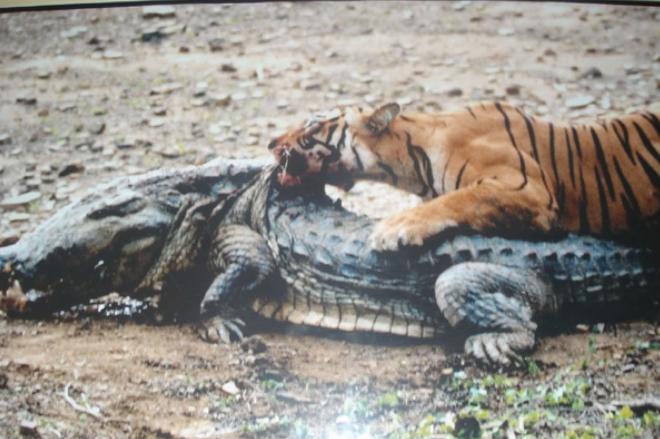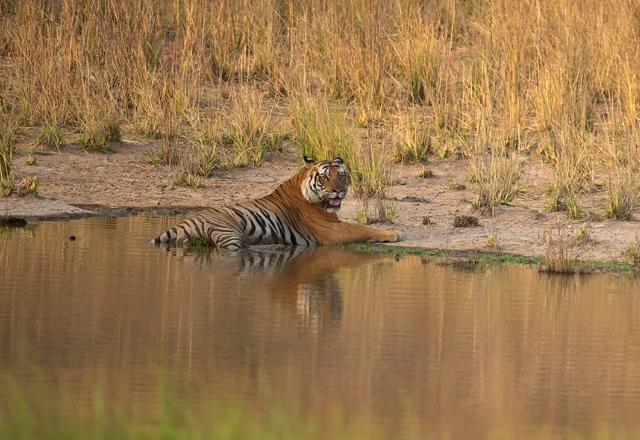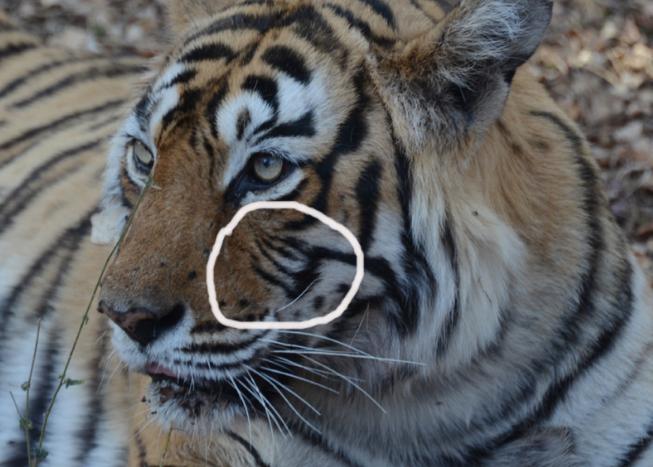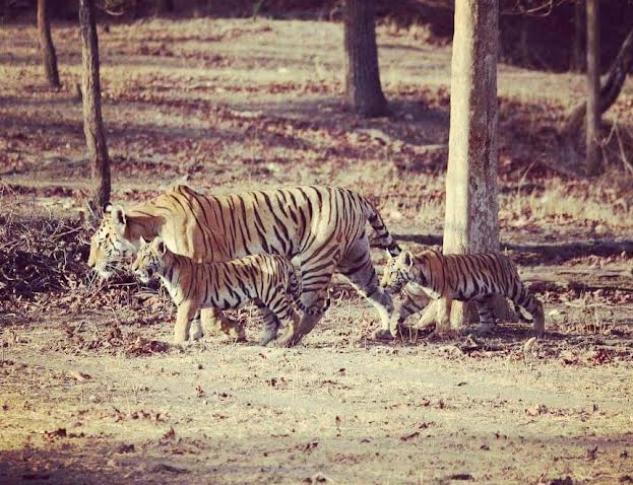Sita: The First Super Mom
Companion of the famous tiger of the park ‘Charger’, Sita gave birth to 16 cubs in her lifetime before she was poached. The pair of Charger and Sita brought Bandhavgarh on the wildlife tourism map of the world. The jungle stories revolving around the duo kept the tourist footfall in the park very high. Charger had a lifetime mate, “Sita”. In 1992 their first litter comprised two male cubs “Langru” and “Bada Bachha”. As the name indicated, Bada Bachha ( Big Sibling) was strong and later claimed his territory around Ghora demon. But the younger son had a slight limp in his hind leg, hence named Langru ( limping one). Langru did not make his own territory instead decided to stay with Charger,a phenomenon that surprised wildlife experts as Charger ,a ferocious territorial male accepted his 4 year old lame son, contradicting the logic that dominant males drive away their own grownup male cubs. Sita’s second litter in March, 1994 with Charger had a blind female cub, which died within six months after its birth.
Also read: Bandhavgarh Needs to Step-up Efforts to Handle Man- Animal Conflict
This shook Sita down to the core. She also had a beautiful female from the same litter, who came to be known as “Mohini” (charming ). A few years later Mohini gave birth three male cubs B1, B2 and B3. In September 1996, Sita produced her fifth litter from Charger comprising one male and two females, one of them was Reshma, who was more fertile then her mom. Though Reshma gave birth to 17 cubs before she died , she was still overshadowed by the popularity of her mom, Sita who went missing in 1997 leaving Charger behind. She was allegedly poached.
Machli : The Queen Mother Of Ranthambhore
Somewhere near the death of Sita, a tigress born in Ranthambhore National Park in Rajasthan, almost 700 kms away from Bandhavgarh. Born in 1996 or 1997, Machli was the dominant cub in a litter of three females. She inherited her name from her mother, Machli ( meaning fish in Hindi) . The reason behind her name was the fish-shaped mark on the left ear of her face. Soon she was grown up and became a ferocious tigress taking over her mother’s territory. Code named T-16, she was usually found near the water bodies of Ranthambore National Park and earned the title “Lady of the Lake”. In the next few years, she was also known as “legendary”, “iconic” and “queen mother”. But her daring act during the drought of 2003 made her a super mom when she protected her cubs from a hungry crocodile. “In June 2003, with Ranthambore in the middle of a drought, a crocodile approached a lake in her territory”, reminisces an officer, “ Machli first escorted her cubs to safety and returned to fight the 14-foot-long crocodile.”
Also read:Tale of Missing Tigers of Ranthambhore: 4 More Takes the Count to 34
After almost 90 minutes of fighting, she emerged the winner and earned a new moniker, “Crocodile Killer.” Over a period of seven years, from 1999 to 2006, Machali had four litters and gave birth to eleven cubs – seven females and four males. She also raised a litter of cubs in her older years without any canine teeth, an incredible act.This had happened during a period when the tiger population in Ranthambhore was declining. Machli's offspring increased the number of big cats in the park significantly – from 15 tigers in 2004, to 50 tigers in 2014. There was a time when more than half of the tigers in the park were of her lineage. In 2008, two of her female cubs were even relocated to Sariska Tiger Reserve, the first tiger reserve where all the tigers had been poached .Machli’s offsprings reestablished the tiger population in Sariska as well. One of the most photographed tigress, Machli died on 18 August 2016. She was about 20 years old, older than the average 10- to 15-year lifespan of tigers in the wild.
Amazingly Fertile , the Charismatic Collarwali
Charismatic Collarwali of Pench tiger reserve was affectionately known as “Mata Ram” or "respected mother" by wildlife lovers - a name she earned over her life. This legendary tigress had broken all the records before her death in January this year. Before dying of old age, she had given birth to as many as 29 cubs, a record of sorts. Her first three cubs died of pneumonia in 2008 but she soon delighted the park management by producing litter after litter at relatively short intervals . They include a litter of five cubs in 2010, a rare feat according to wildlife experts
Also read: Fertility Stories Immortalise Collarwali Tigress of Pench Tiger Reserve
She was born in 2005 as T-15 - her mother, known as "badi mata" or "big mother" was also a famous tigress. She was known as CollarwaIi because of a radio collar put around her neck in 2008. Though the collar was discarded few years later, the name was tagged to her forever. As she gave birth to 29 cubs, she not only populated the Pench Park, but her progeny are also spread over Satpura tiger landscape which include the neighbouring jungles of the state of Maharashtra. She became one of India's best-known tigers after starring in the BBC Wildlife documentary, Spy in the Jungle, which tracked the lives of four tiger cubs over two years. The documentary triggered a surge in wildlife tourism in the park. She too obliged the tourists and never disappointed. Till she was alive, sighting was assured. Till recently, no tiger has been able to fully capture her territory in Pench. The tiger sighting has been very low in the park .Though Langdi, one of her litters, seems to be occupying her mother’s space to become the next queen of the park , her sighting is also not assured. The park and wildlife tourists continue to miss the super mom.
Machli Images by Ranthambhore National Park





Comments
Post a Comment